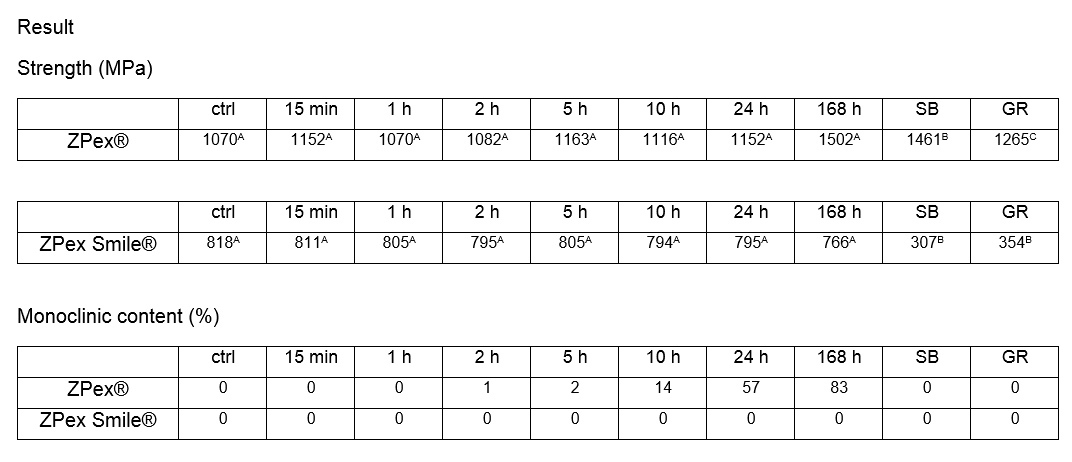IADR Abstract Archives
Mechanical Behavior and Crystallographic Study of 3Y-TZP and 5Y-TZP
Objectives: This study aimed to compare the effect of surface treatments and artificial steam aging on biaxial flexural strength and monoclinic contents of Y-TZP with two different Yttria concentration; 3Y-TZP and 5Y-TZP.
Methods: Materials
Two types of Tosoh Y-TZP (Tosoh Corporation, Japan) were used
3Y-TZP (Tosoh ZPex®): Translucent zirconia powder
5Y-TZP (Tosoh ZPex Smile®): Extra translucent zirconia powder
Methods
Two Y-TZP powders were pressed and sintered to full density following manufacture firing schedules. Final dimensions of each disc were about 15 mm diameter and 1.2 mm thick.
Specimens were divided into10 groups for each type of Y-TZP. As sintered, 7 groups were put in to closed aluminium chamber bomb with water. All the specimens were separated from water by steel wool then kept in 134oC for 15 minutes, 1, 2, 5, 10, 24 and 168 hours at 2 atm. The last 2 groups were treated by 50 micron sandblasting, grinding with 240 µm diamond particle. (N=10/group)
Monoclinic content analysis was done using Bruker D8. Biaxial flexural strength was determined using a ball on three ball apparatus at a cross head speed of 1 mm/min.
Results: Please refer to image 1
Conclusions: With the limitations of this in vitro study, the following conclusions can be drawn:
1. There was a significant difference in biaxial flexural strength values between Tosoh 3Y-TZP (ZPex®) and 5-YTZP (ZPex Smile®).
2. Artificial steam aging had no any significant effects on biaxial flexural strength of all Tosoh Y-TZP.
3. Artificial steam aging had a significant role in increasing monoclinic phase of Tosoh 3Y-TZP (ZPex®), but not 5Y-TZP (ZPex Smile®), over time.
4. Sandblasting had a significant effect on biaxial flexural strength of Tosoh Y-TZP by increasing biaxial flexural strength Tosoh 3Y-TZP (ZPex®)by 36.92%; on the other hand, it decreases biaxial flexural strength of 5Y-TZP (ZPex Smile®)by 56.67%.
5. Grinding 240 μm diamonds particle significantly increased biaxial flexural strength of 3Y-TZP (ZPex®) by 18 % but decreased biaxial flexural strength 5Y-TZP (ZPex Smile®) by 57%
6. All surface treatments had a significant role in increasing a small amount of monoclinic phase of of 3Y-TZP (ZPex®) but not 5Y-TZP (ZPex Smile®).
Methods: Materials
Two types of Tosoh Y-TZP (Tosoh Corporation, Japan) were used
3Y-TZP (Tosoh ZPex®): Translucent zirconia powder
5Y-TZP (Tosoh ZPex Smile®): Extra translucent zirconia powder
Methods
Two Y-TZP powders were pressed and sintered to full density following manufacture firing schedules. Final dimensions of each disc were about 15 mm diameter and 1.2 mm thick.
Specimens were divided into10 groups for each type of Y-TZP. As sintered, 7 groups were put in to closed aluminium chamber bomb with water. All the specimens were separated from water by steel wool then kept in 134oC for 15 minutes, 1, 2, 5, 10, 24 and 168 hours at 2 atm. The last 2 groups were treated by 50 micron sandblasting, grinding with 240 µm diamond particle. (N=10/group)
Monoclinic content analysis was done using Bruker D8. Biaxial flexural strength was determined using a ball on three ball apparatus at a cross head speed of 1 mm/min.
Results: Please refer to image 1
Conclusions: With the limitations of this in vitro study, the following conclusions can be drawn:
1. There was a significant difference in biaxial flexural strength values between Tosoh 3Y-TZP (ZPex®) and 5-YTZP (ZPex Smile®).
2. Artificial steam aging had no any significant effects on biaxial flexural strength of all Tosoh Y-TZP.
3. Artificial steam aging had a significant role in increasing monoclinic phase of Tosoh 3Y-TZP (ZPex®), but not 5Y-TZP (ZPex Smile®), over time.
4. Sandblasting had a significant effect on biaxial flexural strength of Tosoh Y-TZP by increasing biaxial flexural strength Tosoh 3Y-TZP (ZPex®)by 36.92%; on the other hand, it decreases biaxial flexural strength of 5Y-TZP (ZPex Smile®)by 56.67%.
5. Grinding 240 μm diamonds particle significantly increased biaxial flexural strength of 3Y-TZP (ZPex®) by 18 % but decreased biaxial flexural strength 5Y-TZP (ZPex Smile®) by 57%
6. All surface treatments had a significant role in increasing a small amount of monoclinic phase of of 3Y-TZP (ZPex®) but not 5Y-TZP (ZPex Smile®).

